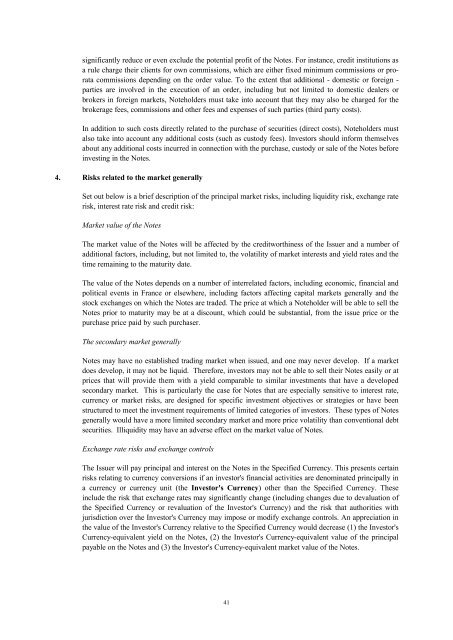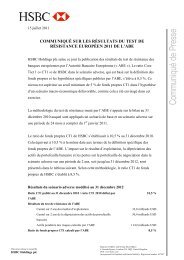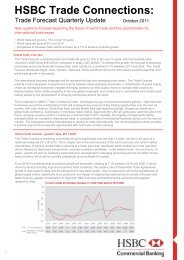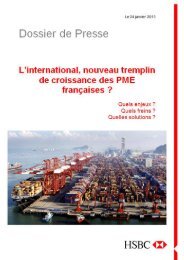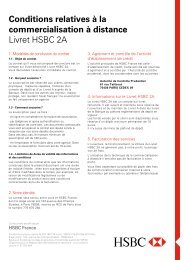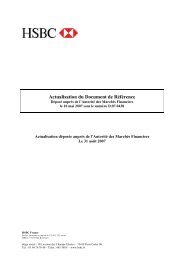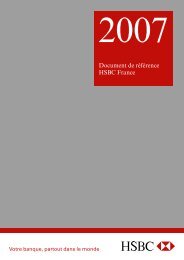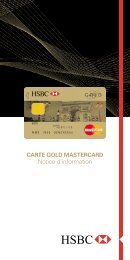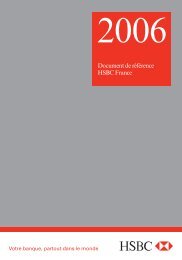HSBC France ⬠20,000,000,000 Euro Medium Term Note Programme
HSBC France ⬠20,000,000,000 Euro Medium Term Note Programme
HSBC France ⬠20,000,000,000 Euro Medium Term Note Programme
You also want an ePaper? Increase the reach of your titles
YUMPU automatically turns print PDFs into web optimized ePapers that Google loves.
significantly reduce or even exclude the potential profit of the <strong>Note</strong>s. For instance, credit institutions asa rule charge their clients for own commissions, which are either fixed minimum commissions or proratacommissions depending on the order value. To the extent that additional - domestic or foreign -parties are involved in the execution of an order, including but not limited to domestic dealers orbrokers in foreign markets, <strong>Note</strong>holders must take into account that they may also be charged for thebrokerage fees, commissions and other fees and expenses of such parties (third party costs).In addition to such costs directly related to the purchase of securities (direct costs), <strong>Note</strong>holders mustalso take into account any additional costs (such as custody fees). Investors should inform themselvesabout any additional costs incurred in connection with the purchase, custody or sale of the <strong>Note</strong>s beforeinvesting in the <strong>Note</strong>s.4. Risks related to the market generallySet out below is a brief description of the principal market risks, including liquidity risk, exchange raterisk, interest rate risk and credit risk:Market value of the <strong>Note</strong>sThe market value of the <strong>Note</strong>s will be affected by the creditworthiness of the Issuer and a number ofadditional factors, including, but not limited to, the volatility of market interests and yield rates and thetime remaining to the maturity date.The value of the <strong>Note</strong>s depends on a number of interrelated factors, including economic, financial andpolitical events in <strong>France</strong> or elsewhere, including factors affecting capital markets generally and thestock exchanges on which the <strong>Note</strong>s are traded. The price at which a <strong>Note</strong>holder will be able to sell the<strong>Note</strong>s prior to maturity may be at a discount, which could be substantial, from the issue price or thepurchase price paid by such purchaser.The secondary market generally<strong>Note</strong>s may have no established trading market when issued, and one may never develop. If a marketdoes develop, it may not be liquid. Therefore, investors may not be able to sell their <strong>Note</strong>s easily or atprices that will provide them with a yield comparable to similar investments that have a developedsecondary market. This is particularly the case for <strong>Note</strong>s that are especially sensitive to interest rate,currency or market risks, are designed for specific investment objectives or strategies or have beenstructured to meet the investment requirements of limited categories of investors. These types of <strong>Note</strong>sgenerally would have a more limited secondary market and more price volatility than conventional debtsecurities. Illiquidity may have an adverse effect on the market value of <strong>Note</strong>s.Exchange rate risks and exchange controlsThe Issuer will pay principal and interest on the <strong>Note</strong>s in the Specified Currency. This presents certainrisks relating to currency conversions if an investor's financial activities are denominated principally ina currency or currency unit (the Investor's Currency) other than the Specified Currency. Theseinclude the risk that exchange rates may significantly change (including changes due to devaluation ofthe Specified Currency or revaluation of the Investor's Currency) and the risk that authorities withjurisdiction over the Investor's Currency may impose or modify exchange controls. An appreciation inthe value of the Investor's Currency relative to the Specified Currency would decrease (1) the Investor'sCurrency-equivalent yield on the <strong>Note</strong>s, (2) the Investor's Currency-equivalent value of the principalpayable on the <strong>Note</strong>s and (3) the Investor's Currency-equivalent market value of the <strong>Note</strong>s.41


